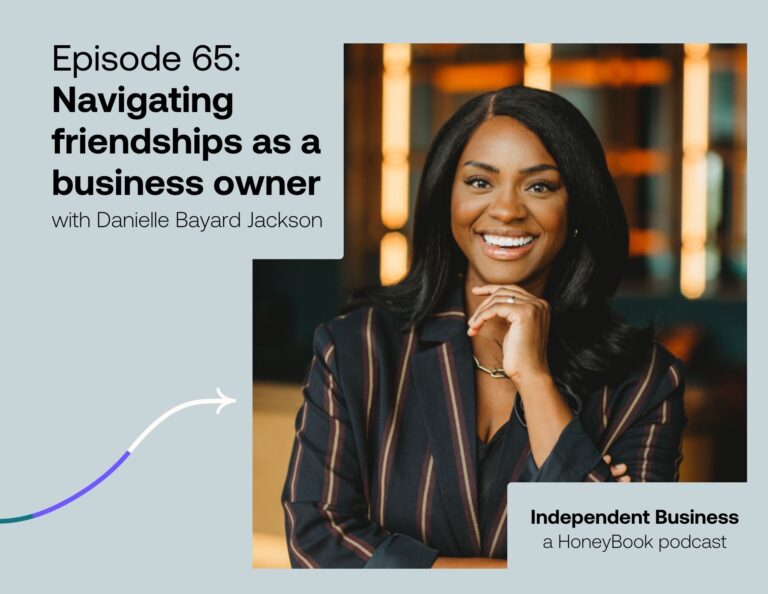
Have you ever responded to a client email or text at 9 p.m. on a Saturday night and dropped what you were doing (or sat down your glass of wine) to tackle a to-do or respond to an inquiry?
Are you “on call” to every client whim because you want to make a lasting impression and prove that you’re on top of things?
Even the most well-organized and intentional business owners can find themselves in a place where their business and clients suck the life out of them.
Every single one of us has to learn how to manage client relationships and set solid boundaries for ourselves and our business, or we will be married to, laboring for, and living in our business to our own detriment.
I have seen it time and time again with friends who are business owners: they are tied to their phones or computers, emailing and responding to messages every minute of the day. While it’s awesome to be in demand—and a definite compliment—it’s also important to be in control, be proactive rather than reactive, and to take a deep breath.
When you lay out a strong foundation of ground rules and do the work to provide all of the information up front, you can optimize your client relationship AND not be tied to your phone, at the mercy of every whim.
But once you set your boundaries, there is one even more important thing to do if you’re really going to avoid burnout, scope creep, and being “on call” 24/7 (even for your most loved clients).
When you set your boundaries, you HAVE to follow them.
The first time you respond outside of your “work hours”, you are opening the door to a relationship where your foundation is cracked and anything can slip in. So what can you do? Follow these tips to avoid burnout and work/life boundary creep:
1. Create work hours when you will respond to messages and emails and STICK TO THEM
The world is not going to burn down around you if you do not answer emails or client questions immediately. If you have a hard time avoiding emails or pings on your phone, sometimes getting a cheapo prepaid phone is the best way to go, so these messages aren’t following you around at all times. This works because you can separate yourself from the incoming messages and create a schedule of when you will check in and respond, BUT still be able to take it with you in an emergency for sessions where your clients might need to contact you right away. (Plus, who doesn’t look cool with a flip phone LOL? I had one for my business for the longest time.)
2. Send a welcome guide that lays out how the process will work and when you will respond to messages
In your welcome packet, lay out your schedule boundaries and provide all the crucial information that your clients will need. For example, if you’re a photographer, let them know how they can get in touch with you the day of—or a certain number of hours before—their shoot in case of an emergency (such as if they can’t find the session location or studio).
However, while this packet has to be full of important details, DO NOT provide too much information, which may cause people to become overwhelmed and not read it.
Try to make this concise and to the point to get to the meat of your boundaries and process, so clients don’t have too many lingering questions they have to email you about.
For tips on how to create a branded welcome packet for clients, visit my post, “How to Elevate Your Client Experience with a Welcome Packet that Has all the Right Pieces”.
3. Have an automatic workflow
By creating an automatic workflow that sends out emails with important information when your clients need it, you ensure your clients are not “just guessing” about any details or asking you unnecessary questions.
Having automated workflows set up in systems such as Honeybook creates more space in your calendar because you’re not physically sitting down to do as many administrative tasks. It also clears up “headspace”, because you don’t have to remember each and every detail in order to make sure that your clients are getting the best experience (and the same experience) each time.
4. Be upfront about what things in life are most important to you
What’s most important in your life? Family, friends, having work/life balance, or “me” time? We all need to be honest with ourselves and our clients about who we are “as real people.” If we’re making a real connection with our clients, they’ll respect the fact (and maybe even be proud of us for it) that we’re upfront about making it a priority to spend time with who and what matters.
As a mama, I have created a schedule that works for me and my family, and I do not bend the rules for anyone. My hubby works a lot of nights, so for me, working outside of my business hours is not an option. In addition, I want to be able to spend time with my family and friends or doing other things that I enjoy without worrying about work 24/7.
As we know, our clients all have different schedules, so we will never be able to adjust to fit everyone’s at once. But if we tell them they can expect communication at certain times, they will not be sitting by the phone thinking we are ignoring them. Instead, they’ll understand that that we’re simply adhering to a set schedule and they will know when to expect a reply. Most of my clients are inspired by my boundaries, and I have only had ONE client back out of a contract because she wanted/needed more attention than my schedule allowed. However, I was upfront about my schedule from the beginning, so I knew it just wasn’t a good fit—no hard feelings.
5. Build a team or ask for help
Now, most of the time when we read “build a team,” we think it’s referring to hiring help in our business—and for many of people, that’s simply not in the budget. BUT, even if hiring an employee or two isn’t feasible, you can still build a team of support.
For example, you can trade time with a fellow parent and watch each other’s kids. More often than not, you will both accomplish SO much more when they are playing together and/or you will have more isolated “work only” time. You can also look into local church groups or community centers that offer free childcare at designated times, which can give you a few precious hours of distraction-free work time.
So often when it comes to burnout or feeling overwhelmed with clients, we already know what to do…we’re just not doing it.
Make a commitment to set some boundaries or stick to the ones you’ve already established and you’ll be amazed at how at ease and refreshed you begin to feel. And the amazing result of that clarity and follow-through will be quality client relationships.
HoneyBook, the best crm for solopreneurs, streamlines everything you need to manage your business into one place. Manage projects, book clients, send an online invoice, and get paid through our online payment software. Now peace of mind comes with just one login.
Get 50% Off from Alicia
Try the easy-to-use booking and invoicing software made for creative business owners.
Start Free Trial >
Want to learn more about building strong client relationships for your small businesses? Get our Ultimate Guide to Client Relationships here.
Plus, 5 more posts you might like:



